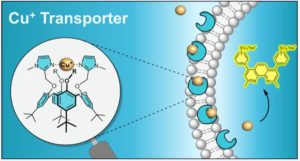Our ChemComm Milestones campaign aims to highlight authors who have published their first independent research article in our journal. We were excited to speak to Hennie Valkenier about her experiences as an emerging author and her #ChemComm1st article: Transmembrane transport of copper(i) by imidazole-functionalised calix[4]arenes.
Read our interview with Hennie here:
What are the main areas of research in your lab and what motivated you to take this direction?
Our main area of research is the development of synthetic transporters for ions and we have a particular interest in the transport of phosphate and phosphorylated compounds, for which I received an ERC starting grant (ORGANITRA). I have always been fascinated by the possibility that chemistry offers to design compounds for any purpose and to then actually synthesise and test these compounds. This process of molecular design, synthesis, and testing allows, firstly, to deepen our understanding of how these compounds function, and secondly, to develop new materials or applications. During my PhD, I worked on organic compounds for applications in molecular electronics. After my PhD, the many health challenges that our society faces and my interest in biological processes prompted me to reorient my research towards supramolecular chemistry. This allowed me to follow my passion to design, synthesise, and study compounds, now with the purpose of transporting ions through lipid bilayers. This research has many fundamental aspects, but also offers perspectives on medical purposes (Chem. Sci. 2019).
Can you set this article in a wider context?
The research efforts on ion transport by synthetic compounds have increased rapidly over the past 20 years. The vast majority of this work focusses on only a limited number of ions (such as Na+, K+, and Cl−), for which the methodology to study the transport process has been well established. The transport of these anions is indeed very important in biology, for instance in signal transduction and homeostasis. However, the transport of other ions, including phosphates and Cu+, also plays a crucial role in biology, while little or no research has been done to try and mimic these processes with synthetic systems. The challenge is that this requires not only the development of compounds that could bind and potentially transport these ions, but also the methodology to study the transport process. Nathan Renier is the first student who had the courage to start a PhD under my supervision and in this ChemComm article we show that it is indeed possible to transport Cu+ through lipid bilayers with synthetic compounds and to monitor this process by fluorescence spectroscopy. These results encouraged us to start exploring the biological effects of Cu+ transporters.
What do you hope your lab can achieve in the coming year?
First of all, I hope that the different team members can continue to grow as researchers and enjoy discoveries (whatever their scale) and hard work paying off. We also hope to find new synthetic transporters, deepen our understanding of transport processes, and transport challenging ions such as phosphates. And with Nathan and various collaborators we hope to demonstrate that we can transport Cu+ into cells.
Describe your journey to becoming an independent researcher.
I am firstly grateful to all my supervisors for their continuous support combined with the freedom to develop my research projects, to try new things, and pursue ideas even if only some of them turned out well. In Groningen, Kees Hummelen allowed me to reorient my research project and set up collaborations with specialists in the field, to work at the forefront of molecular electronics. In Bristol, Tony Davis has introduced me to the field of supramolecular chemistry and ion transport during the 3 years I worked with him as a postdoc. In his group, I also had the privilege to work with several PhD students, allowing me to gain experience in supervision. Through the “Supramolecular Chemistry in Water” COST network, I met with Kristin Bartik and Gilles Bruylants from Brussels (ULB), whose “Engineering of Molecular NanoSystems” laboratory I joined to look at anion binding and transport from a rather different perspective. They also taught me and supported me in the writing of grant proposals, starting with small grants for equipment, to later arrive at the grant for my permanent research position with the national research council FNRS and an ERC starting grant, which launched my career effectively.
What is the best piece of advice you have ever been given?
When thinking about grant proposals, my colleagues at the ULB told be to dream big. It feels safer to propose a project that is close to what is known to work, but aiming for something that we can currently only dream about is worth the risk. Another very good piece of advice, from Tony Davis, concerns publishing results: Tell a story. Research data is indispensable, but rationalising the trends observed and drawing conclusions that are more general and teach lessons that are also applicable to the research projects of other people is a lot more interesting.
Why did you choose to publish in ChemComm?
ChemComm reaches a very broad audience, which is a great platform for our interdisciplinary research. Furthermore, the clear and concise format of ChemComm is highly suitable for a proof-of-concept article. I also had good experiences with the RSC, in their fair and professional handling of manuscripts. Thus, we were delighted to see Nathan’s first article on Cu+ transport published in ChemComm.
Find Hennie’s work, and other #ChemComm1st articles, in ChemComm Milestones – First Independent Articles.
Find out more on our Twitter #ChemCommMilestones #ChemComm1st.












